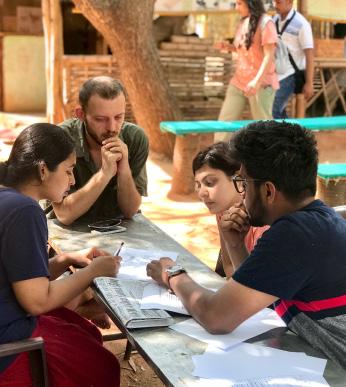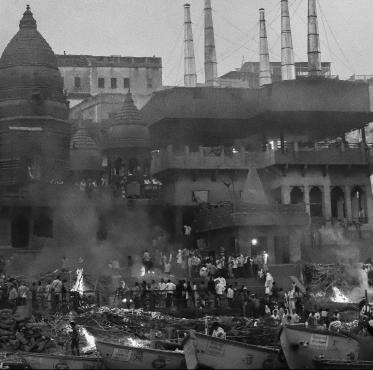
4 minute read
Experiencing the material Earth
from KEYSTONE 1920
Aakash Karnavat III Yr karnavat27@gmail.com
In the world of concrete creations, a medium like mud is hardly taken seriously as a construction material.We talk about how we have stopped using mud, but many rural households contextual to our country are still building with mud. It is just that the government building housing schemes promote reinforced cement concrete for the poor & the middle class has set off a notion that concrete is the only proper and satisfactory material to be used. Well to enquire my concerns, I attended a 30 day, 4 part long training programme in Auroville Earth Institute, Tamil Nadu. The workshops were CSEB PRODUCTION, CSEB MASONRY, CSEB DESIGN & exploring Earth & Bamboo as a material. We were in a group of 4 to explore all possibilities of the material exploration. We were guided by the co founder of Auroville Earth Institute, T. Ayyapaan who taught us on site working and the founder Satprem Maine who was teaching us theory as well as the calculation included in it. For CSEB PRODUCTION, we started off with learning the scientific properties, sustainability and environmental friendliness of earth as a material. Going ahead, we learnt about identifying soils, stabilizing soil, quality control, making special blocks and optimizing production. For CSEB MASONRY, we had to test the mortar quality, bonds for various types of walls, casting beams, lintel, plinth beam, building compound column, building a CSEB wall and a stabilized earth plaster. With this we were introduced to the building basics of arches, vaults and domes where we built free spaning vaults, a great hands-on experience. For CSEB DESIGN, we started with the very basics of bond pattern exercises with the mud blocks we produced, later we started designing on auto cad with some pre set rules to design (basic principles + structural components + foundation calculations).We did case studies of Vikas Community of Auroville, The Al Medy Mosque of Riyadh & the Natraja Temple of Tamil Nadu to understand the beauty of earth. The founder Satprem Maine was kind enough to accompany us to the Natraja Temple followed by a vegan dinner in the evening. Thanks to T Ayyapaan and his masons who offered us lemon juice & cut watermelon every now and then between our workshop hours. Mud buildings are environment friendly and natural, but are now being replaced by concrete. Getting to experience mud as a material in depth, I think we should have a collective conscience about the material and not leave it to government to set or lay down a notion to the people to roll upon.
Advertisement


VARANASI – As we see it.
Archana Bhatia III Year archanabhatia1020@gmail.com
Banaras, a spiritual city where people attain eternal peace or moaksh, a city which celebrates death, illuminates the truth and breathes culture. It is older than the history we know and has evolved to modernism but stayed ancient inside. A home to all casts, creeds and religions, holding its importance with changing time. Banaras saw many invaders and sunk them inside and enriched its history. This city ensconces on the unique location of Ganga, with miles of ghats, for religious bathing; an array of shrines, temples, and palaces rises tier on tier from the water’s edge. Varanasi has been a city of Hindu learning through the ages. There are innumerable schools and countless Brahman pandits, who are pledged to continue their ancestral literature. There are three universities, including the large and important Banaras Hindu University (1915).The city is a home of arts and crafts and of music and dance. Varanasi is famous for its production of silks and brocades with gold and silver thread work. Wooden toys, bangles made of glass, ivory work, and brass ware are also produced in Varanasi. A melting pot of cultures of India, the architecture of Kashi reflects diversity in construction and pattern. Ancient buildings falling to ruins, strong - proud pillars, traditional balconies, graceful arches, red brickwork, coherent lanes, intrusive modern buildings, soot covered temples and carpets of ash is what brings you to Banaras.
Most of these Ghats have been built during the rule of the Marathas, while some were built over the ages during invasions. Special stories linking lineages, mythologies, epics and the timelines of history are associated with each of the Ghats. Over 80 Ghats that line the River Ganga; starting from Raj Ghat in the South to Assi Ghat in the North, each unfurls a different style of architecture, all find a space amidst the never-ending, horizontal Ghats.
The Ghats are connected with stone steps leading down to the River or up, towards the street side markets, the pillared balconies with intricate jali work, the small niches for windows or shops that go unnoticed, the obscured temples among the homes and stone carved window supports with creepers crawling out from the porches. Certain types of interactions amongst people, are expected from this architecture. Over the decades, people have absorbed the architecture and modified it to their cultural and religious beliefs, they have a contrast attitude towards life, where people come to die. Modern times ask for a revolution in architecture and lifestyle that persist today, which doesn’t only imply of reconstruction. Completely reconstruction of settlements will destroy the legacy of Banaras, its uniqueness and solidarity. The ancient needs to be preserved with an added touch of the modern facilities. Restoration of these spaces will maintain the character and add the heritage to Kashi. The city has always weaved its history and exists in its purest form. We have to perpetuate Kashi for the coming generation to see its antiquity for what it is.









